Design and Analysis of Particulate Matter Air-Microfluidic Grading Chip Based on MEMS
Abstract
1. Introduction
2. Theoretical Analysis
3. Configuration and Methods
3.1. Configuration of the Channels and VIs
3.2. Simulation Methods
3.2.1. Governing Equations
3.2.2. Boundary Conditions for Laminar Flow (SPF) and Particle Tracing for Fluid Flow (FPT)
3.2.3. Optimization Method
4. Parameter Optimization and Numerical Analysis
4.1. Influence of Second Channel Width (S) and Main Flow Width (L) on Collection Efficiency
4.2. Influence of Split Ratio (Q1/Q) on Collection Efficiency
4.3. Analysis of Flow Rate and Pressure
4.4. Analysis of Trajectories with Different PM Size
4.5. Analysis of Different Inlet Flows
5. Result of the Simulation
6. Conclusions
Author Contributions
Funding
Conflicts of Interest
References
- Boldo, E.; Medina, S.; LeTertre, A. Apheis: Health impact assessment of long-term exposure to PM2.5. Eur. J. Epidemiol. 2006, 21, 449–458. [Google Scholar] [CrossRef] [PubMed]
- Pope, A.; Dockery, D.W. Health Effects of Fine Particulate Air Pollution: Lines that Connect. J. Air Waste Manag. Assoc. 2006, 56, 709–742. [Google Scholar] [CrossRef] [PubMed]
- Kim, K.H.; Kabir, E.; Kabir, S. A review on the human health impact of airborne particulate matter. Environ. Int. 2015, 74, 136–143. [Google Scholar] [CrossRef] [PubMed]
- Abbey, D.E.; Nishino, N.; McDonnell, W.F.; Burchette, R.J.; Knutsen, S.F.; Lawrence, W. Long-term inhalable particles and other air pollution related to mortality in nonsmokers. Am. J. Respir. Crit. Care Med. 1999, 159, 373–382. [Google Scholar] [CrossRef] [PubMed]
- Kioumourtzoglou, M.A.; Schwartz, J.D.; Weisskopf, M.G. Long-term PM2.5 Exposure and Neurological Hospital Admissions in the. Environ. Health Perspect. 2016, 124, 23–29. [Google Scholar] [CrossRef] [PubMed]
- Harrison, R.M.; Yin, J. Particulate matter in the atmosphere: Which particle properties are important for its effects on health? Sci. Total Environ. 2000, 249, 85–101. [Google Scholar] [CrossRef]
- Dong, M.Z.; Iervolino, E.; Santagata, F. Integrated Virtual Impactor Enabled PM2.5 Sensor. IEEE Sens. J. 2017, 17, 2814–2821. [Google Scholar] [CrossRef]
- Kim, Y.H.; Maeng, J.Y.; Park, D. Micromachined cascade virtual impactor with a flow rate distributor for wide range airborne particle classification. Appl. Phys. Lett. 2007, 91, 043512. [Google Scholar] [CrossRef]
- Wada, M.; Tsukada, M.; Namiki, N. A Two-Stage Virtual Impactor for In-Stack Sampling of PM2.5 and PM10 in Flue Gas of Stationary Sources. Aerosol Air Qual. Res. 2016, 16, 36–45. [Google Scholar] [CrossRef]
- Fahimi, D.; Mahdavipour, O.; Cados, T.; Kirchstetter, T.; Solomon, P.; Gundel, L.; White, R.; Lunden, M.; Fukuhima, N.; Nagai, H.; et al. MEMS Air-Microfluidic Lad-on-a-Chip sensor for personal monitoring of airborne particulate matter (PM2.5). In Proceedings of the A Solid-State Sensors, Actuators, and Microsystems Workshop Technical Digest, Hilton Head, SC, USA, 5–9 June 2016; pp. 336–339. [Google Scholar]
- Terry, S.C.; Jerman, J.H.; Angell, J.B. A gas chromatographic air analyzer fabricated on a silicon wafer. IEEE Trans. Electron Devices 1979, 126, 1880–1886. [Google Scholar] [CrossRef]
- Manz, A.; Arrison, R.A.; Verpoorte, E.M. Planar chips technology for miniaturization and integration of separation techniques into monitoring systems: capillary electrophoresis on a chip. J. Chromatogr. A 1992, 593, 253–258. [Google Scholar] [CrossRef]
- Chen, T.; Yeh, H.C. An improved virtual impacted impactor: Design and performance. J. Aerosol Sci. 1987, 18, 203–214. [Google Scholar] [CrossRef]
- Chang, P.K.; Hsiao, T.C.; Engling, G. Computational fluid dynamics study of the effects of flow and geometry parameters on a linear-slit virtual impactor for sampling and concentrating aerosols. J. Aerosol Sci. 2019, 131, 28–40. [Google Scholar] [CrossRef]
- Paprotny, I.; Doering, F.; White, R.M. MEMS Particulate Matter (PM) Monitor for Cellular Deployment. In Proceedings of the IEEE SENSORS 2010 Conference, Kona, HI, USA, 1–4 November 2010; Volume 978, pp. 2435–2440. [Google Scholar]
- Paprotny, I.; Doering, F.; Solomon, P.A. Microfabricated air-microfluidic sensor for personal monitoring of airborne particulate matter: Design, fabrication, and experimental results. Sens. Actuators A Phys. 2013, 201, 506–516. [Google Scholar] [CrossRef]
- Lee, H.; Jo, D.; Kim, W.G. Effect of an Orifice on Collection Efficiency and Wall Loss of a Slit Virtual Impactor. Aerosol Sci. Technol. 2014, 48, 121–127. [Google Scholar] [CrossRef]
- Wang, Y.; Wang, Y.S.; Liu, X.X. An aerosol sensor for PM1 concentration detection based on 3D printed virtual impactor and SAW sensor. Sens. Actuators A 2019, 5, 10–16. [Google Scholar] [CrossRef]
- Chiang, C.T. Design of a High-Sensitivity Ambient Particulate Matter 2.5 Paarticle Detector for Personal Exposure Monitoring Device. IEEE Sens. J. 2018, 18, 165–169. [Google Scholar] [CrossRef]
- Hinds, W.C. Aerosol Technology: Properties, Behavior, and Measurement of Airborne Particles, 2nd ed.; John Wiley and Sons: New York, NY, USA, 1999. [Google Scholar]
- Marple, V.A.; Chien, C.M. Virtual Impactors: A Theoretical Study. Environ. Sci. Technol. 1980, 14, 975–985. [Google Scholar] [CrossRef]
- Xu, X.; Li, Z.; Nehorai, A. Finite element simulations of hydrodynamic flow in a driven skewed cavity. ZAMM-Z. Angew. Math. 2007, 87, 377–392. [Google Scholar]
- Erturk, E.; Dursun, B. Numerical solutions of 2-D steady incompressible flow in a driven skewed cavity. ZAMM-Z. Angew. Math. Mech. 2007, 87, 377–392. [Google Scholar] [CrossRef]
- Wright, P.K.; Dornfeld, D.A.; Chen, A.; Ho, C.C.; Evans, J.W. Dispenser printing for prototyping microscale devices. Trans. NAMRI/SME 2010, 38, 55–561. [Google Scholar]
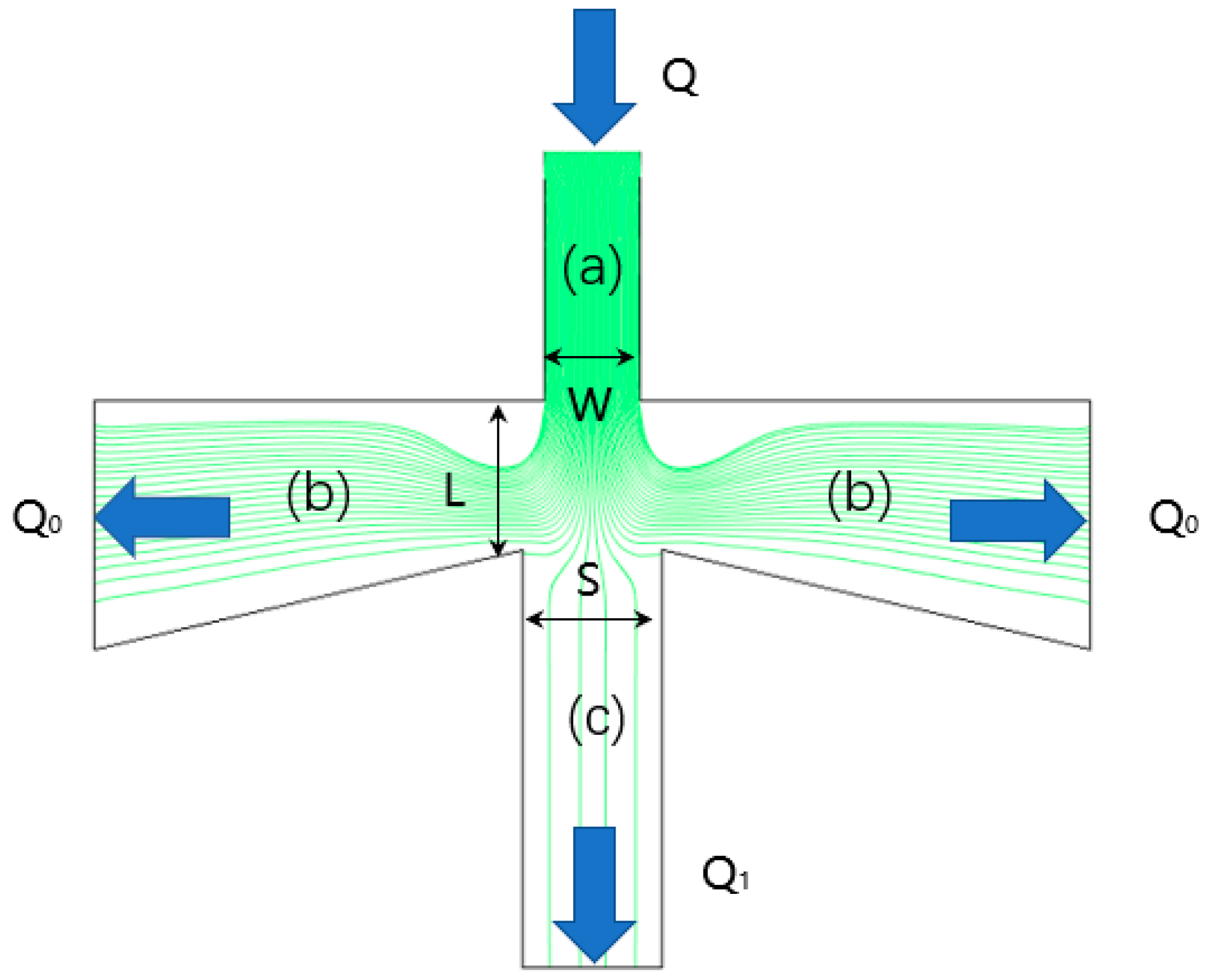
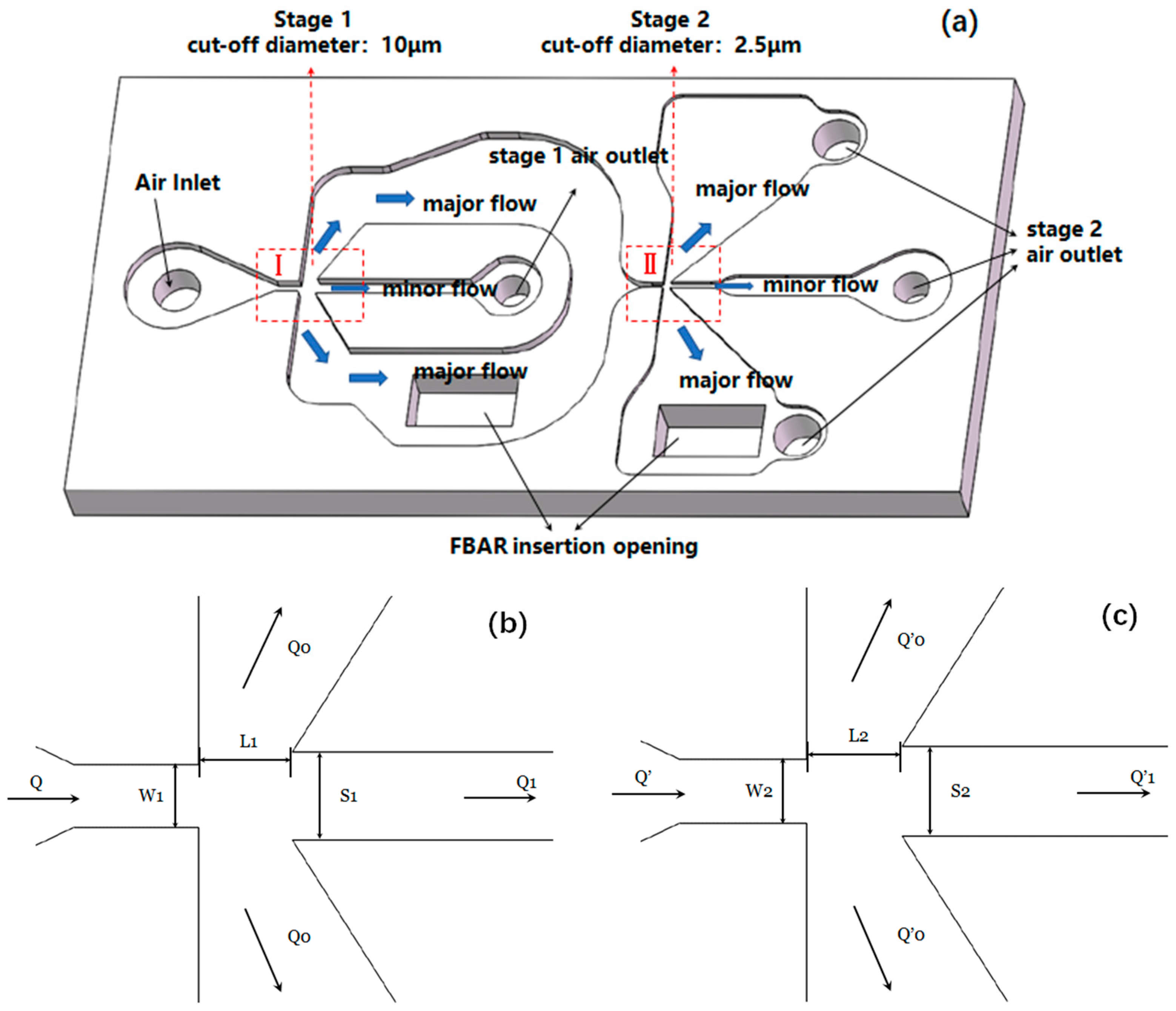

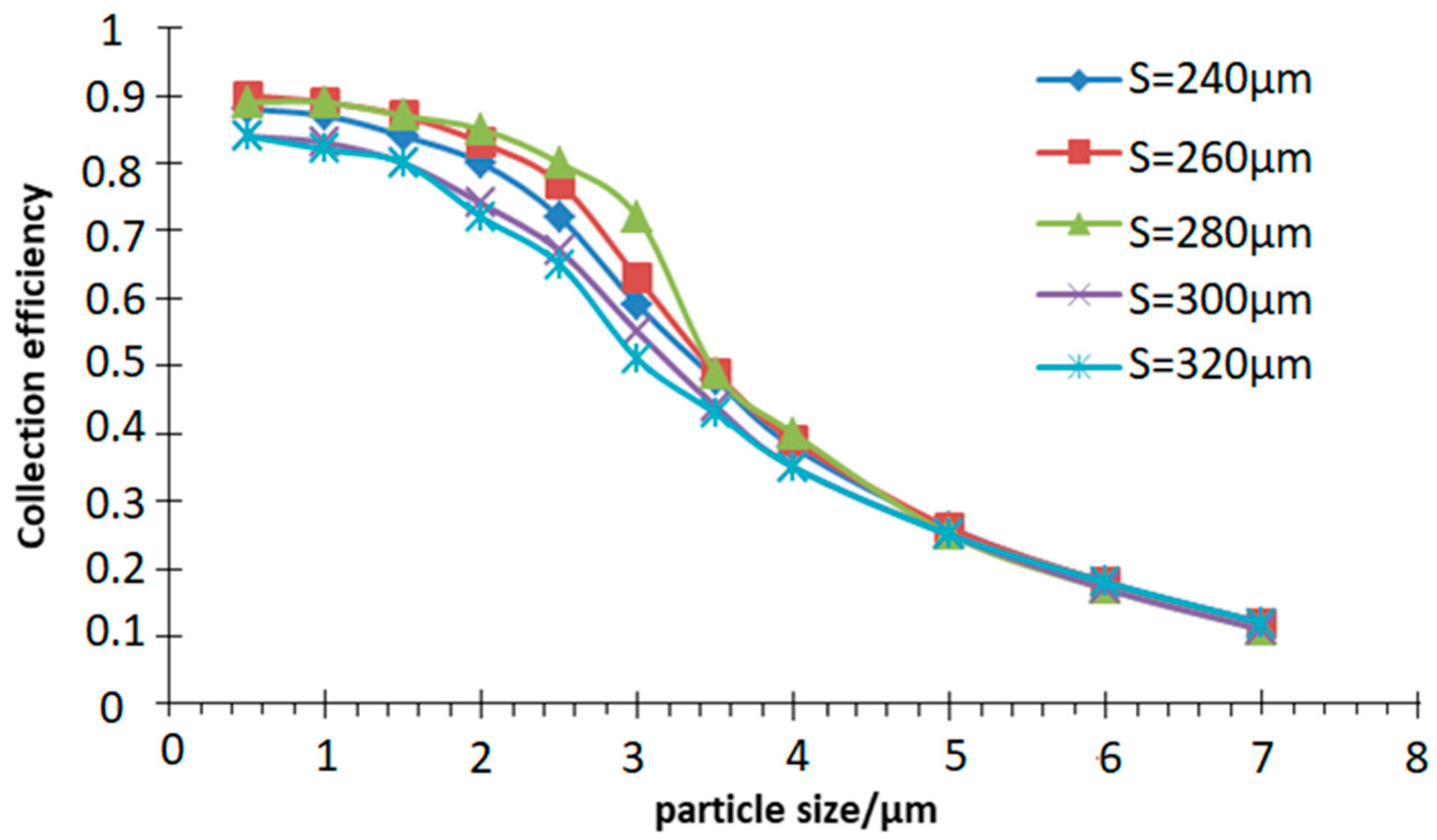

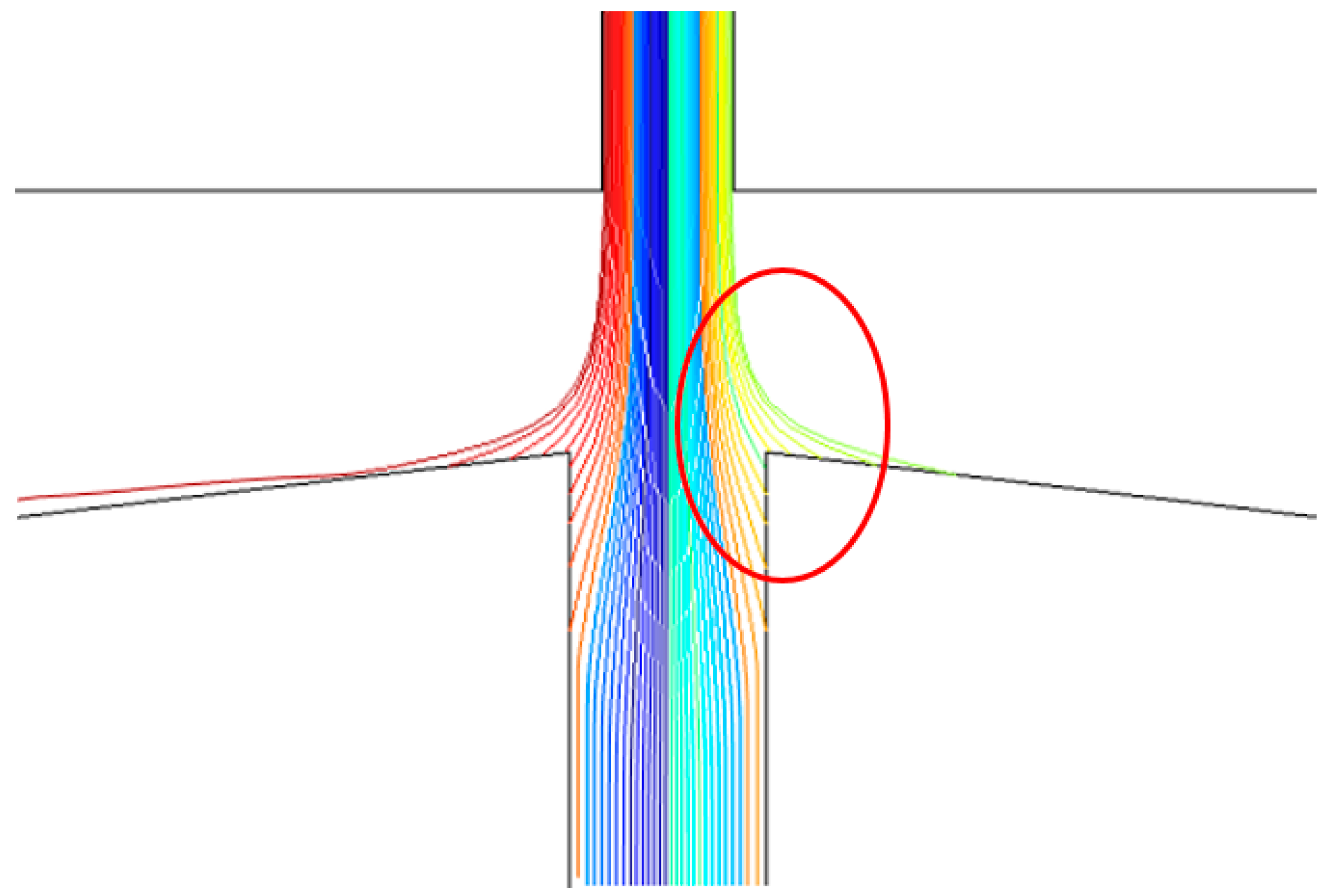
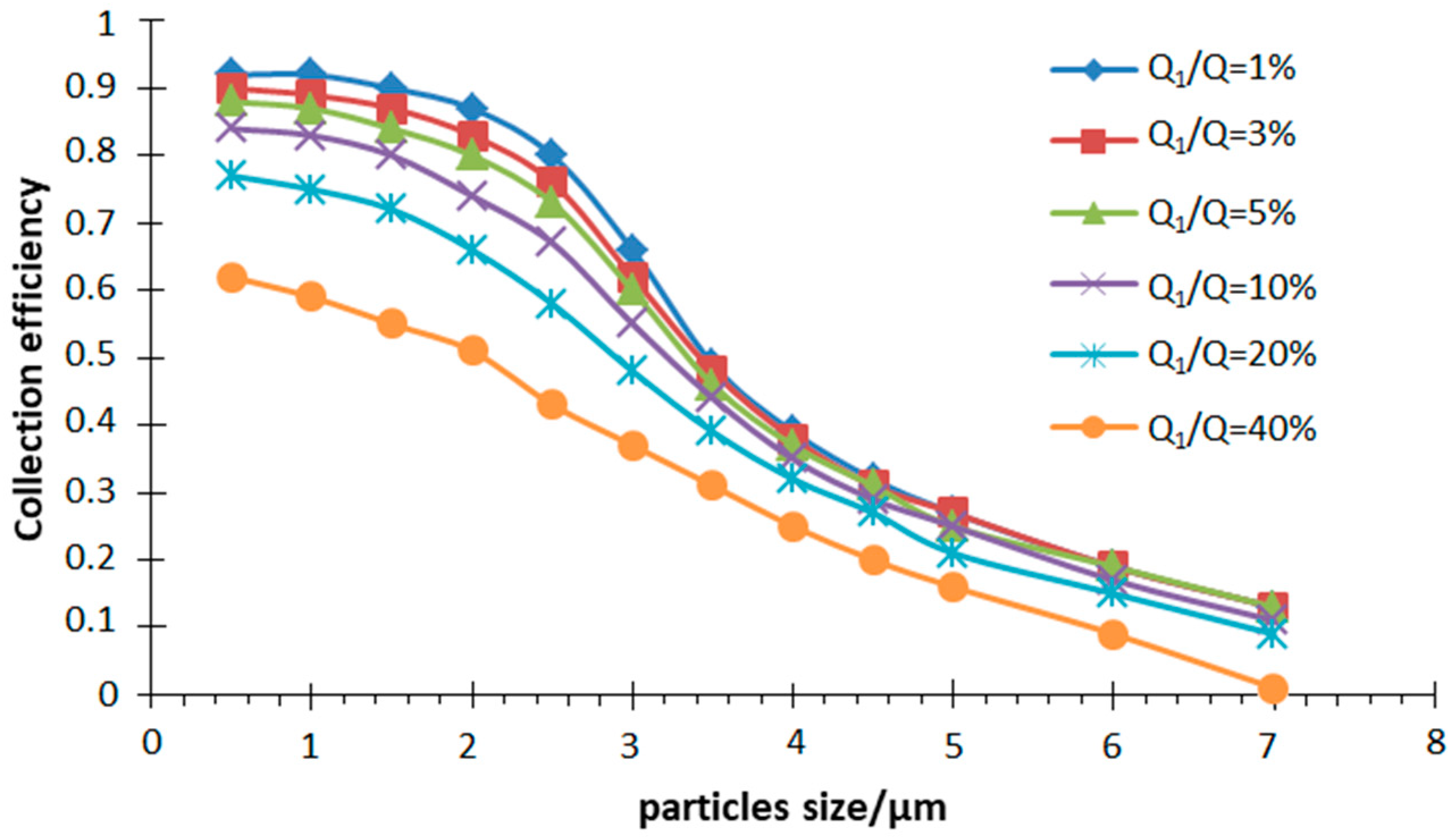
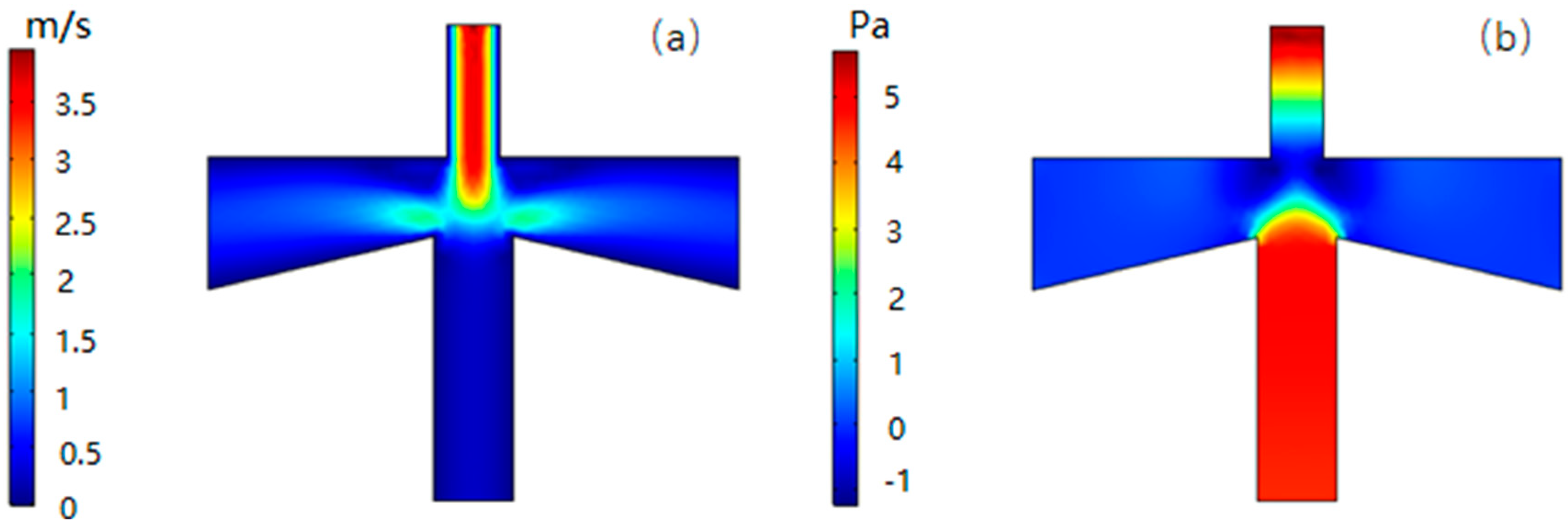
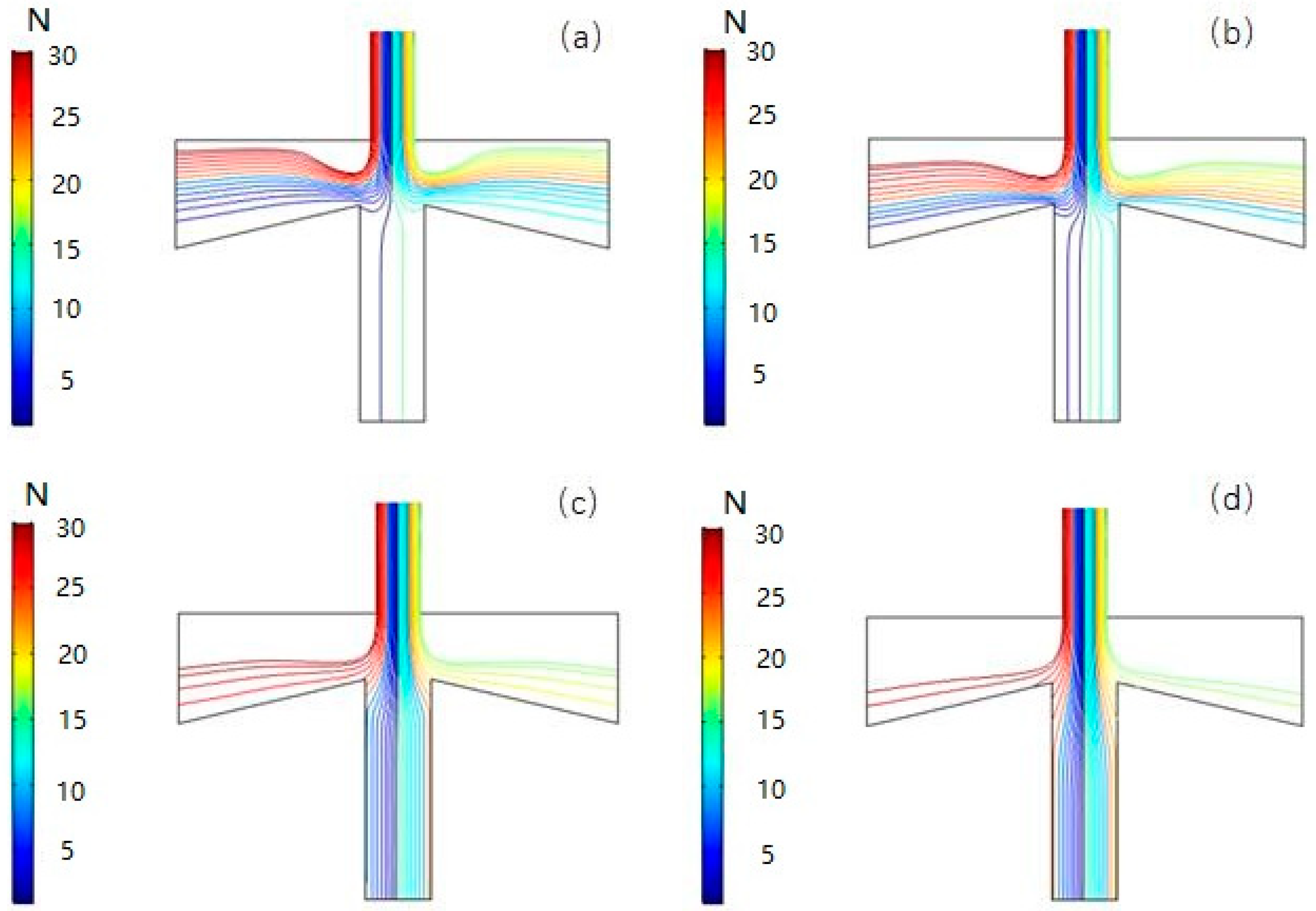



| Variable | VALUE | Unit |
|---|---|---|
| W1 | 500 | μm |
| L1 | 750 | μm |
| S1 | 700 | μm |
| W2 | 200 | μm |
| L2 | 280 | μm |
| S2 | 300 | μm |
| D | 200 | μm |
| Q | 6.9 | mL/min |
| Q1/Q | 10% | - |
| Q’1/Q’ | 10% | - |
| Property | Ours | I. Paprotny et al. [16] | Kim et al. [8] |
|---|---|---|---|
| Grading number | 2 | 1 | 3 |
| The target cut-off diameter | 2.5 μm and 10 μm | 2.5 μm | 6 μm, 2.5 μm, and 200 nm |
| The fitted cut-off diameter | 2.5 μm and 10 μm | 2.5 μm | 4.8 μm, 1.9 μm, and 135 nm |
| Curve steepness | Both stages are good | Good | As the number of stages increases, the steepness deteriorates. |
© 2019 by the authors. Licensee MDPI, Basel, Switzerland. This article is an open access article distributed under the terms and conditions of the Creative Commons Attribution (CC BY) license (http://creativecommons.org/licenses/by/4.0/).
Share and Cite
Chen, T.; Sun, J.; Ma, T.; Li, T.; Liu, C.; Zhu, X.; Xue, N. Design and Analysis of Particulate Matter Air-Microfluidic Grading Chip Based on MEMS. Micromachines 2019, 10, 497. https://doi.org/10.3390/mi10080497
Chen T, Sun J, Ma T, Li T, Liu C, Zhu X, Xue N. Design and Analysis of Particulate Matter Air-Microfluidic Grading Chip Based on MEMS. Micromachines. 2019; 10(8):497. https://doi.org/10.3390/mi10080497
Chicago/Turabian StyleChen, Tingting, Jianhai Sun, Tianjun Ma, Tong Li, Chang Liu, Xiaofeng Zhu, and Ning Xue. 2019. "Design and Analysis of Particulate Matter Air-Microfluidic Grading Chip Based on MEMS" Micromachines 10, no. 8: 497. https://doi.org/10.3390/mi10080497
APA StyleChen, T., Sun, J., Ma, T., Li, T., Liu, C., Zhu, X., & Xue, N. (2019). Design and Analysis of Particulate Matter Air-Microfluidic Grading Chip Based on MEMS. Micromachines, 10(8), 497. https://doi.org/10.3390/mi10080497







